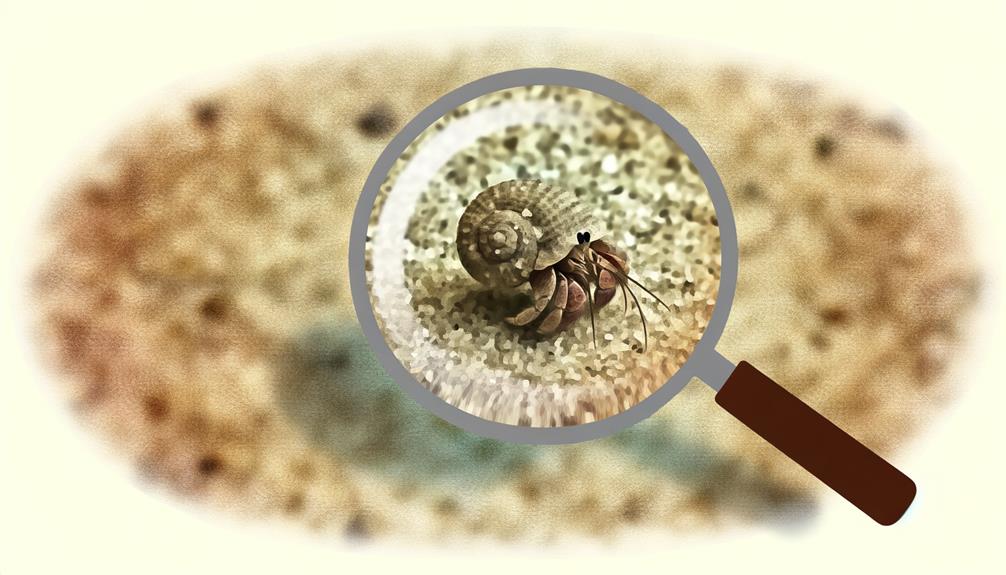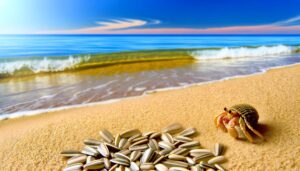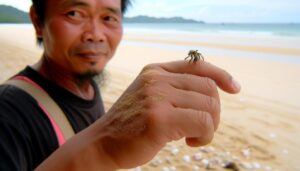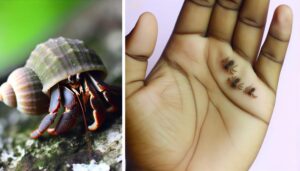Do Hermit Crabs Eat Aiptasia: 3 Reasons They Won’t
Yes, hermit crabs can carry Salmonella. When you handle them, you risk contracting the bacteria, which leads to symptoms like diarrhea, fever, and abdominal cramps.
Salmonella can persist on their shells and in their habitat, highlighting the importance of strict hygiene practices. Wash your hands thoroughly with soap and water after handling crabs or cleaning their habitat to prevent infection.
It's vital to sanitize surfaces and avoid touching your face during interaction. If you follow these steps, you'll notably lessen the risk of Salmonella transmission.
There's more to learn about safe handling practices and preventive measures.

Key Takeaways
- Hermit crabs can carry Salmonella, posing a risk to humans through direct contact.
- Contaminated hermit crab habitats facilitate Salmonella transmission.
- Handling hermit crabs without proper hygiene increases the risk of infection.
- Salmonella can survive on hermit crab shells for extended periods.
- Regular hand washing and habitat disinfection reduce the risk of Salmonella transmission.
Understanding Salmonella
Salmonella, a genus of bacteria responsible for causing foodborne illnesses, often resides in the intestines of various animals and can be transmitted to humans through contaminated food or water.
You should know that Salmonella infections can lead to symptoms like diarrhea, fever, and abdominal cramps. The Centers for Disease Control and Prevention (CDC) report that these bacteria are responsible for approximately 1.35 million infections and 420 deaths annually in the U.S.
Proper handling and cooking of food are vital to preventing infection. In addition, maintaining proper hygiene and sanitation when dealing with animals or their habitats can mitigate the risk.
Hermit Crab Biology
Hermit crabs, belonging to the superfamily Paguroidea, are fascinating crustaceans that utilize discarded shells for protection and exhibit unique behaviors essential for their survival.
You'll find that hermit crabs display a remarkable behavior called “shell exchange,” where they switch shells to accommodate their growing bodies. They've soft, vulnerable abdomens that necessitate this constant search for suitable shells.
Hermit crabs are omnivorous scavengers, feeding on a variety of organic matter, which includes detritus and decaying animal material. Their gills require a moist environment to function properly, making them dependent on humid conditions.
Additionally, they possess chelae (claws) of different sizes, which they use for defense and foraging. Understanding these biological traits is vital for anyone aiming to care for them responsibly.
Transmission of Salmonella
You can contract Salmonella from hermit crabs through direct contact with their shells, which often harbor the bacteria.
Contaminated habitat conditions, such as unclean water and substrate, further facilitate the spread of Salmonella.
Handling hermit crabs without proper hygiene practices, such as washing hands thoroughly, markedly increases the risk of transmission.
Contact With Shells
When dealing with hermit crab shells, the risk of contracting Salmonella increases due to the bacteria's ability to survive on these surfaces for extended periods. To minimize this risk, strict hygiene protocols must be followed.
Here are four evidence-based practices to follow:
- Wash Hands Thoroughly: Use soap and water for at least 20 seconds after handling shells.
- Disinfect Surfaces: Regularly clean any surfaces the shells come into contact with a disinfectant known to kill Salmonella.
- Avoid Eating/Drinking: Never consume food or beverages while handling hermit crab shells to prevent accidental ingestion of bacteria.
- Use Disposable Gloves: Wear gloves when handling shells and dispose of them properly to reduce direct contact and cross-contamination.
Contaminated Habitat Conditions
Contaminated habitat conditions greatly contribute to the transmission of Salmonella among hermit crabs. When you neglect habitat cleaning, bacterial colonies can thrive, heightening the risk of Salmonella outbreaks.
Uneaten food, waste, and stagnant water are prime breeding grounds for Salmonella bacteria. Research shows that high moisture and organic material levels notably increase bacterial proliferation.
Handling Without Hygiene
Improper hygiene practices during the handling of hermit crabs greatly elevate the risk of Salmonella transmission to humans. When you fail to wash your hands thoroughly after touching these creatures or their habitats, you create a direct pathway for bacterial contamination.
To mitigate this risk, adhere to these evidence-based guidelines:
- Cleanse hands with soap and water for at least 20 seconds immediately after handling hermit crabs or cleaning their enclosures.
- Refrain from eating or drinking while interacting with your pets to prevent accidental ingestion of bacteria.
- Sanitize surfaces and tools used in the care of hermit crabs regularly with a bleach solution.
- Educate others in your household about these hygiene practices to ensure a detailed approach to preventing Salmonella transmission.
These steps are essential for safeguarding public health.
Risks to Humans
Handling hermit crabs infected with Salmonella can pose significant health risks to humans, leading to severe gastrointestinal illness. When you come into contact with an infected hermit crab or its habitat, the bacteria can transfer to your hands and surfaces you touch.
Salmonella is known to thrive in various environments, making it essential to maintain stringent hygiene practices. You should always wash your hands thoroughly with soap and water after handling the crabs and cleaning their enclosures. It's important to disinfect any surfaces that come into contact with the crabs to prevent cross-contamination.
Symptoms of Infection
Recognizing the symptoms of Salmonella infection is essential, as they typically include nausea, vomiting, abdominal cramps, diarrhea, fever, and headache, which can appear 6 to 72 hours after exposure. These symptoms are your body's response to the bacterial invasion and can vary in severity. Monitoring these signs can help in early detection and prompt treatment.
Here's what to look for:
- Nausea and Vomiting: Common indicators of gastrointestinal distress.
- Abdominal Cramps: Often severe, resulting from inflammation.
- Diarrhea: Can lead to dehydration if not managed properly.
- Fever and Headache: Indicate systemic infection and immune response.
Understanding these symptoms helps in identifying and addressing potential infections, ensuring timely medical intervention.
Preventative Measures
To minimize the risk of salmonella infection from hermit crabs, you should practice regular hand washing with soap and water after handling them.
Additionally, maintaining a clean habitat by regularly disinfecting enclosures and accessories can greatly reduce bacterial contamination.
Ensuring these measures are followed consistently can help protect both you and your pets from potential health issues.
Regular Hand Washing
Regular hand washing is important for preventing the transmission of Salmonella from hermit crabs to humans, as studies show that thorough hand hygiene can greatly reduce bacterial contamination.
You should follow these evidence-based steps to ensure effective hand washing:
- Use warm water: Wet your hands with tepid, flowing water to help loosen any dirt and bacteria.
- Apply soap: Use a generous amount of soap and lather well. Soap molecules can trap and remove bacteria.
- Scrub for at least 20 seconds: Pay attention to all hand surfaces, including between fingers and under nails, where bacteria often hide.
- Rinse and dry: Rinse thoroughly with water and dry with a clean, disposable towel to avoid recontamination.
Clean Habitat Practices
Maintaining a clean habitat is crucial for reducing the risk of Salmonella transmission from hermit crabs to humans. A well-sanitized environment minimizes bacterial proliferation.
You should regularly clean the crab's tank and accessories with hot water and a mild, pet-safe disinfectant. Remove uneaten food promptly to prevent bacterial growth. Replace the substrate every few weeks and guarantee proper ventilation to reduce humidity, which can foster bacteria.
Monitor water quality by changing it every 2-3 days and using a water conditioner to eliminate contaminants. Avoid overcrowding the tank, as it can increase stress and susceptibility to illness in hermit crabs, indirectly affecting their Salmonella carriage.
Safe Handling Practices
When handling hermit crabs, always wear disposable gloves to reduce the risk of contracting salmonella. This precaution minimizes direct contact with potential pathogens.
Additionally, follow these evidence-based practices:
- Sanitize Surfaces: Clean any surfaces touched by your hermit crabs with a disinfectant known to kill salmonella bacteria.
- Wash Hands: Even after removing gloves, wash your hands thoroughly with soap and water for at least 20 seconds.
- Avoid Face Contact: Don't touch your face, especially your mouth, nose, or eyes, when handling hermit crabs to prevent bacterial transfer.
- Separate Handling Areas: Designate specific areas for handling hermit crabs away from food preparation zones to prevent cross-contamination.
When to Seek Help
If you experience symptoms like severe diarrhea, abdominal cramps, or fever after handling hermit crabs, seek medical attention promptly to rule out salmonella infection.
It's important to act quickly because salmonella can lead to serious, sometimes life-threatening complications, especially in young children, the elderly, or those with weakened immune systems.
Document your symptoms accurately and inform the healthcare provider about your recent interaction with hermit crabs.
Providing this information helps them choose the appropriate diagnostic tests, such as stool cultures, to confirm the infection.
Early intervention can prevent the escalation of symptoms and ensure a quicker recovery.
Don't delay seeking help, as timely treatment with antibiotics or supportive care can be vital in mitigating the effects of this bacterial infection.
Conclusion
Imagine your hermit crab scuttling across its sandy habitat, a small but fascinating glimpse into marine life. While these creatures can carry Salmonella, you're not powerless. By understanding the biology, transmission methods, and taking preventative measures, you can reduce risks.
Always wash your hands and sanitize equipment after handling. If you notice any symptoms of infection, seek medical help immediately. Your attention guarantees a safe and enjoyable experience with your curious, shelled companion.






